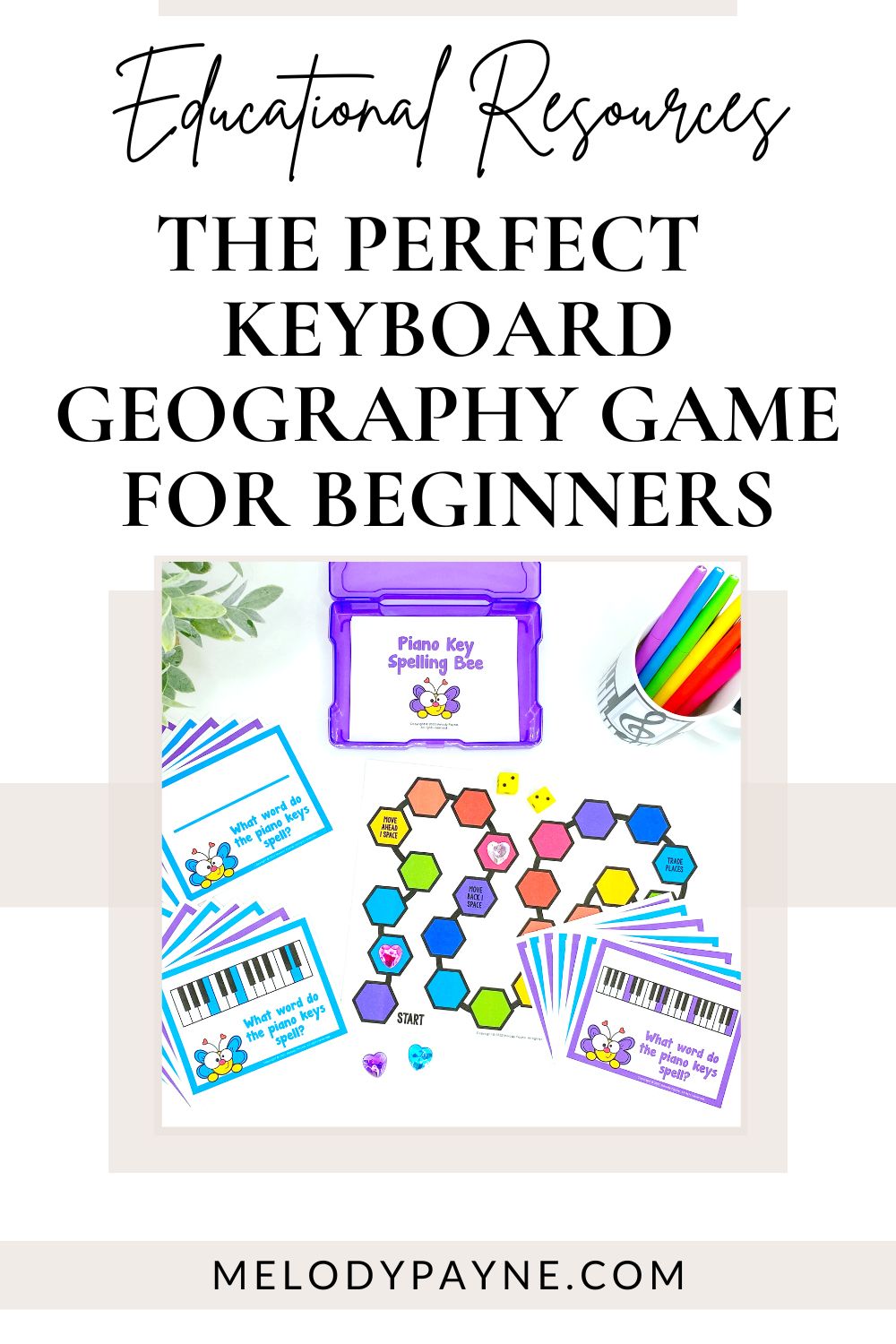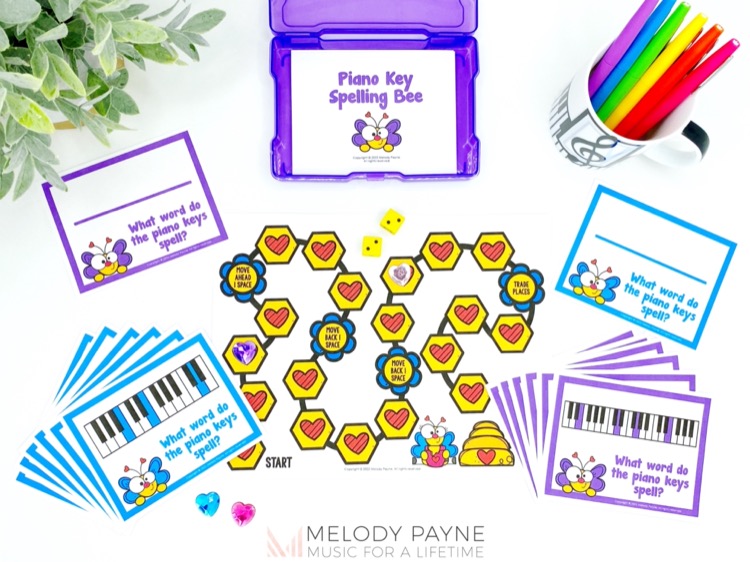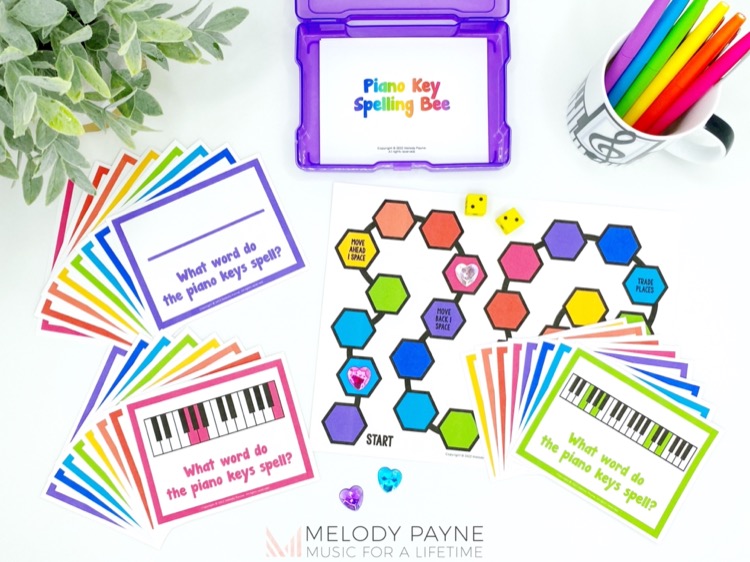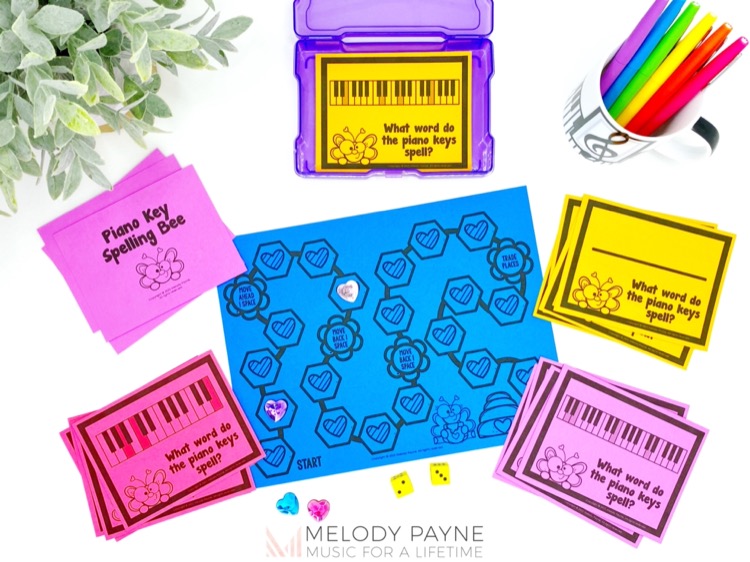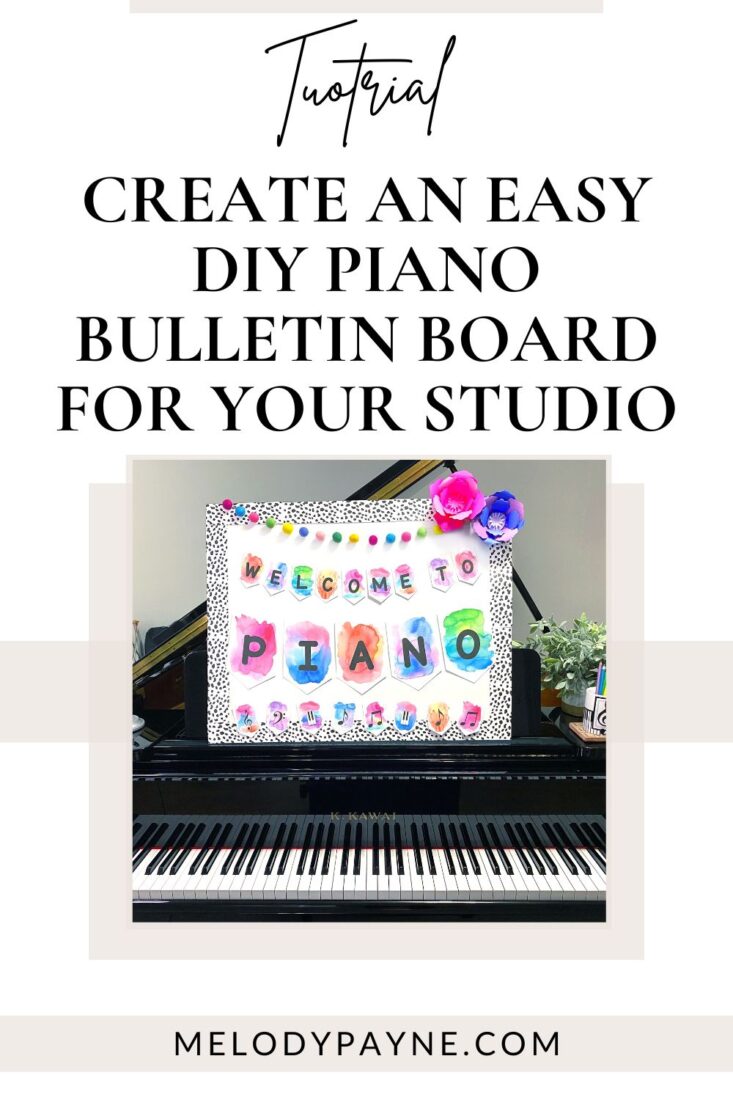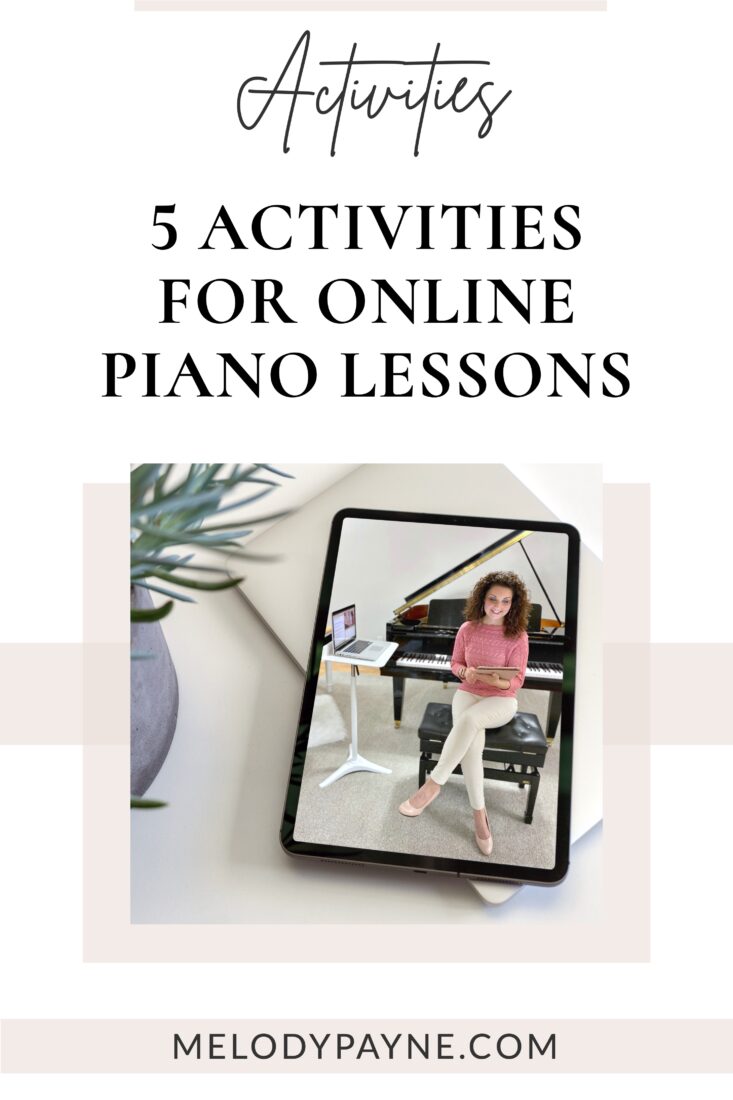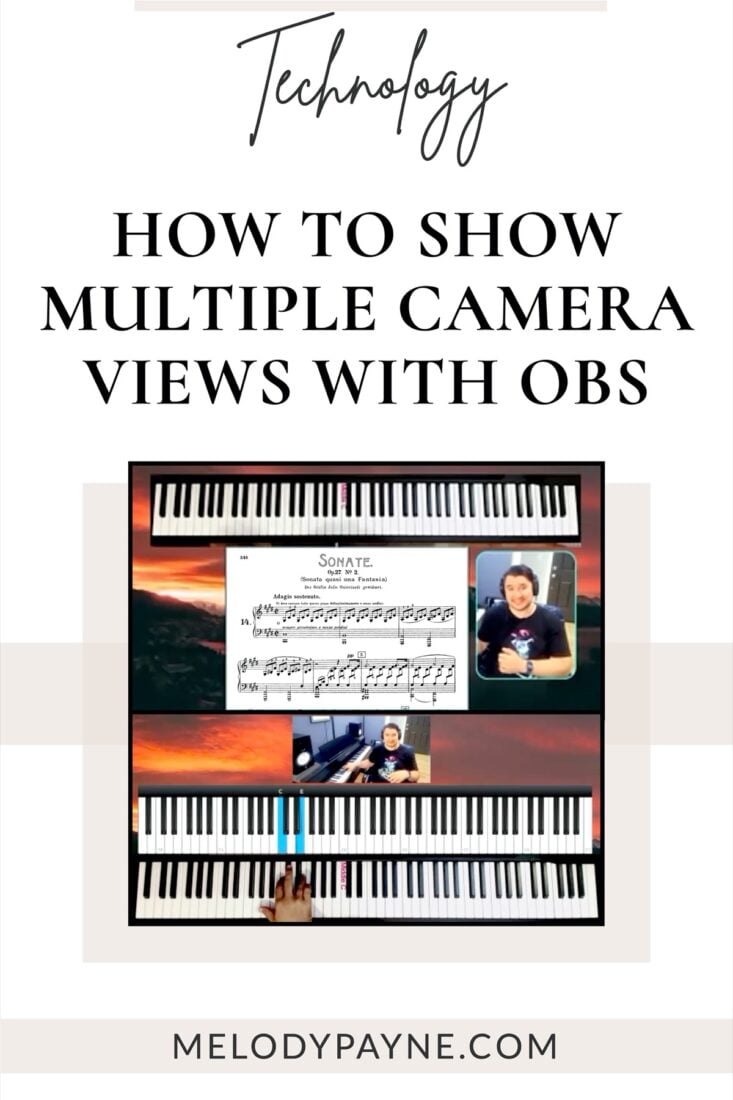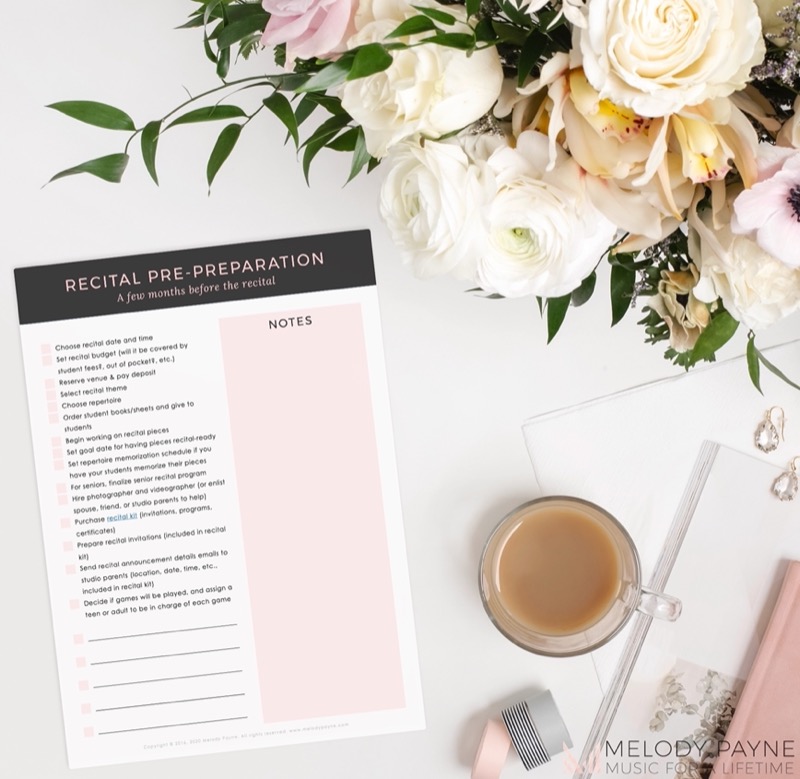The Perfect Keyboard Geography Game for Beginner Piano Lessons
This post may contain affiliate links. If you purchase something through an affiliate link, I will receive a small commission at no cost to you. For more information, read the disclosure statement here.
One of my favorite aspects of teaching piano is getting the opportunity to teach students transferable skills or knowledge that will come in handy outside of their piano lessons. For preschool and kindergarten piano students, learning keyboard geography helps them to get extra practice in identifying visual patterns, especially when playing a game like Piano Keys Spelling Bee.
The game includes a game board and a total of thirty-two cards, with an equal number of 3- and 4-letter words. You will need to print double-sided manually if you would like to print the ‘Piano Key Spelling Bee’ design (just one page) on the back of each of the cards to keep them organized.
Also included are extra cards for either the teacher or the student to create any words that are not already included as part of the thirty-two cards.
There are also cards where students can fill in ‘What Words Do the Piano Keys Spell?’ It is recommended to laminate these cards so the student can write (depending on the age of the student) the correct answer.
In this post I’ll be sharing 3 reasons I enjoy using the Piano Keys Spelling Bee Game in lessons as well as a few tips that may come in handy.
3 Reasons I Enjoy Using the Piano Keys Spelling Bee Game
1) Transferable Skills: Keyboard Geography + Letters and Simple Words
I enjoy using the Piano Keys Spelling Bee Game for younger students, ages 4-6, because it ties right into what they are learning in preschool and kindergarten. Students in this age range are learning their letters and learning what words go along with the sounds of those letters.
I am very precise about lesson activities because it absolutely must be a beneficial use of instruction time and not just filling time. Being able to reinforce skills young students are already learning in school in the context of learning keyboard geography is such a valuable use of our limited time together.
4-year-olds are not expected to be able to fill out the written answer portion. Depending on readiness, the student could try to write one letter they are familiar with, or they can simply skip the written portion altogether until they are developmentally ready for it (if you have a studio full of preschoolers, read Tips for Teaching Preschool Piano Students).
2) Use with Different Ages: Keyboard Geography for Beginners through Late Beginners Ages 7+
This game can be used for students ages 7+, and even at the late beginner level. For example, I discovered that a couple of my 8-year-old late beginners could use a brush-up on keyboard geography after we started working on pieces that had them changing hand positions every measure or so.
3) Flexible Use: Keyboard Geography Off-Bench or At the Piano
While the game board is nice to have, it is not necessary to use the game board or to use the game as an off-bench activity.
Depending on the age of the student, you may decide to make it a quick keyboard geography flash card activity that you complete right at the piano. Older beginners may just need a quick review and can go through all the cards under five minutes.
And if you’re an online piano teacher, read 3 Easy Ways To Use Printable Games In Online Piano Lessons.
5 Quick Tips for Using the Piano Keys Spelling Bee Game
- I really like that there are design and color options for the teacher to choose from. You can choose between the black-and-white or color bee design, or rainbow colors. Before printing it out, I asked one of my preschool students to choose their favorite and they picked the rainbow. So, rainbow it is!
- One of the benefits of using the rainbow design is that you can keep students engaged by saying: “Let’s see how many rainbow-colored cards you can collect!” Students will be excited to complete the game just so they can collect their favorite colors.
- You can make this a tactile game you play directly on the piano:
- Teacher gives the student a word to spell on the piano without showing them the card
- Have the student place a game board piece to ‘mark’ each letter on the piano key
- You can use the same strategy above but instead of playing the game at the piano, you can play it as an off-bench activity using a cloth staff and game chips
- If the idea of using printed board game activities in lessons is overwhelming, try assembling just one or two games that you would like to try within your studio based on student needs. Print it out on card stock (no need to laminate) and try it out. Check out HP Instant Ink if you would like to explore an easier way to print colored pages.
This is a fun keyboard geography game that can be used with all your beginning students, and especially your preschool and kindergarten piano students who need to switch frequently from on and off-bench activities during their lessons.
Grab the Piano Keys Spelling Bee Game today and help your students master keyboard geography, and reinforce their early reading skills.
Read more music games & activities blog posts:
Don't miss out!
Follow us on Facebook and Instagram, join our Facebook group for piano teachers, and subscribe to the newsletter to get helpful teaching tips, resources, and tutorials delivered straight to your inbox every week.
Michelle
Michelle
Welcome!
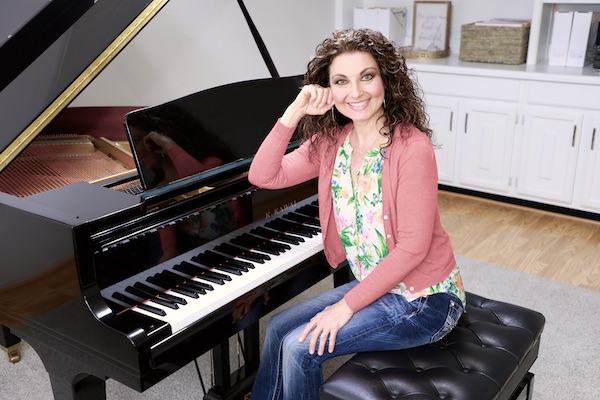
Hi! I’m Melody Payne, a pianist and piano teacher, educational resource author, a fun-loving wife to the most wonderful and talented hubby I could ask for, and a lifelong learner who loves to share. I want to make your life as a music teacher easier by writing and sharing helpful and relevant music teaching articles, and by creating educational resources with your very own students in mind. If you are a parent who wants to enroll your child in piano lessons, I’d love for us to get started building those skills that can give your child a lifetime of musical enjoyment!

